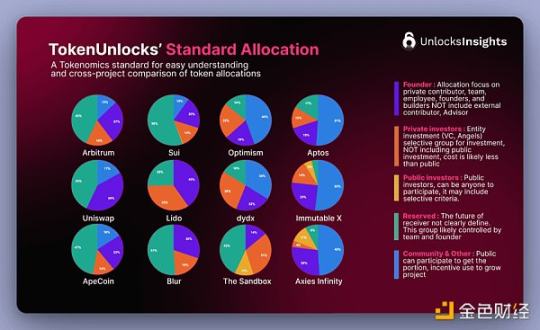Why do some top cryptocurrency project tokens perform poorly?
Original author: ardizor, cryptocurrency researcher
Original compilation: xiaozou, Jinse Finance
Why Token Economics is Very Important:
- Good token economics: 10,000% growth in a year.
- Bad token economics: 90% decline in a year.
In this article, I will reveal all the secrets of token economics.

Here, I want to discuss an important topic that can save you hundreds or even thousands of dollars. That is learning and growing from the mistakes of others. When I didn’t understand how token economics worked, I made some bad investments that are now down 80% compared to when I initially bought them.
Without mastering token economics, any investment purchase is just a gamble on favorable price movements. This is why you should avoid blind trading, or you may suffer significant losses!
When evaluating potential investments, we can see the following on the token page:
- Market Capitalization (MC)
- Fully Diluted Valuation (FDV)
- Circulating Supply
- Total Supply
Each of these is a crucial factor for making informed decisions. Here’s why:

These are known as fundamental supply indicators.
Mastering these indicators can help you assess the potential of a token.
It is essential to understand the functions of each indicator and their impact on cryptocurrency prices.
- MC: The value of circulating supply in USD
- FDV: The value of total supply in USD
- Circulating Supply: The tokens currently in circulation
- Total Supply: All tokens that could possibly exist
Next, we will discuss the three main factors that determine the issuance and success of any token today:
Factor 1: Token Distribution
There are two distribution methods:
- Pre-mining ------ shared among early supporters, teams, and advisors
- Fair launch ------ everyone has an equal opportunity to purchase
In today’s market, most token distributions use the pre-mining method.

If 50% is allocated to investors and 100% will have a TGE (Token Generation Event), investors may sell off their tokens.
Therefore, it is crucial to understand the following points:
- TGE allocation
- Cliff period
- Vesting period
The Token Generation Event (TGE) marks the moment when the token is officially released. TGE allocation refers to the percentage of tokens distributed among individuals, usually between 10-20%. The Cliff is the initial span after the TGE, a pause before the subsequent vesting begins. Vesting means gradually distributing a certain percentage of tokens each month.

Factor 2: Recipients of Distribution
Common recipients of distribution include:
- Airdrops
- Marketing
- Public sales (retail investors)
- Private placements (investors, KOLs, etc.)
- Ecosystem (staking, rewards, etc.)
and so on…

Recently, many projects have been adopting a strategy of moderate TGE (not exceeding 20%), followed by a cliff period of several months, and a vesting period of over a year. This approach is more suitable for promoting the long-term success of the project. It is very important to verify these details before investing.
Factor 3: Demand
On the other hand, the prosperity of any token must rely on demand. This is what drives people to buy. For example, despite facing significant inflation issues, people continue to buy the dollar because it is essential for daily life.
In general, there are four main factors driving token demand:
Factor 1: Community Support
As seen in recent cycles, a strong community can significantly drive demand. For example, the value of meme coins skyrocketed solely due to community support.
Factor 2: Store of Value
Many people buy cryptocurrencies to store wealth, much like investing in digital gold. Bitcoin is a typical example.
Factor 3: Token Utility
Tokens that provide practical functions tend to attract buyers. A simple example is staking, where holding tokens can provide specific benefits.
Factor 4: Value Generation
People seek tokens that can provide real value. Staking allows users to lock their tokens and receive rewards regularly, which also benefits network development. Additionally, holding tokens can yield rewards, airdrops, and other incentives from projects, benefiting all parties involved.

Moreover, regardless of how high the demand is, it is crucial to understand who holds the assets. Is it a strong community, or are there whales? This can be difficult to determine, as you need to engage with the project community and conduct careful analysis. But it is definitely worth it.
Also, keep this in mind: even if token economics are terrible, token prices can still be very high, and vice versa.
Keep this outcome in mind! Welcome to the crypto world, where even the most absurd things can come true.

Conclusion
To avoid making blind investments that lead to unwanted tokens, always consider the following factors:
- Total supply and circulating supply
- Distribution and recipients of distribution
- Vesting period
- Distribution percentage
- Demand
After conducting a prudent analysis, you will be able to determine whether a project is worth investing in.










